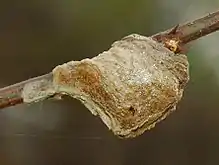Sang piao xiao
Sang piao xiao or Sangpiaoxiao (Chinese: 桑螵蛸,[1] sometimes called Mantis Cradle[2] or Ootheca Mantidis[3][4] in English) is a Pinyin transliteration referring to the oothecae, or egg case, of the praying mantis as an ingredient in traditional Chinese medicine. A formula based on this ingredient is known as sang piao xiao san (or sangpiaoxiao san) and is also known as "mantis formula" in English.[1] The formula may also be sold as a pill ("sang piao xiao wan").[5]
Varieties
The three most common varieties of sang piao xiao are:[1][6]
- tuan piao xiao (round mantis egg case[6]) made from the egg case of Tenodera sinensis
- chang piao xiao (long mantis egg case[6]) made from the egg case of Statilia maculata
- hei piao xiao (black mantis egg case[6]) made from the egg case of Hierodula patellifera
Royal jelly and silkworm droppings are other insect secretions used in traditional Chinese medicine.[1]
History
The use of praying mantis egg case as a medicine is described in the Shennong Bencao Jing, a pharmacological treatise on Chinese herbology from circa 100 AD.[7] Their medicinal use might originate from their occasional occurrence on the mulberry plant Morus alba. As its leaves were necessary food for the caterpillars that make silk, much of the plant – including branches, fruits, leaves, and root bark – became revered in ancient China as source of herbal medicine. Says one source, "it would not be surprising that these egg cases, which appeared on some of the plants, were also collected and considered a valuable medicine."[1]
Collection
Othecae are made by mantises in the late summer and they are collected for medicinal use from then until early spring before when they hatch. The egg cases are steamed – killing the developing nymphs inside – and then sun dried or dried in an oven.[1]
References
- Subhuti Dharmananda. "SANGPIAOXIAO SAN: Example of a "Mind-Body" Formula". Institute for Traditional Medicine.
- "Plum Flower - Mantis Cradle Sang PiaoXiaoWan". morningstarhealth.com. Archived from the original on 2009-04-14. Retrieved 2008-08-20.
- "Introduction To Mantis Egg-Case (sang piao xiao)". tcmtreatment.com.
- This seems to be fake Latin, perhaps invented by one online purveyor and picked up by other websites
- "Schisandra Fruit Fructus Schisandrae". healthphone.com.
- "Famous Doctors in Traditional Chinese Medicine". famousdoctorstcm.org. Archived from the original on 2011-07-26.
- Yang Shouzhong (translator) (1997). The Divine Farmer's Materia Medica. Boulder, CO: Blue Poppy Press.
{{cite book}}:|author=has generic name (help)
